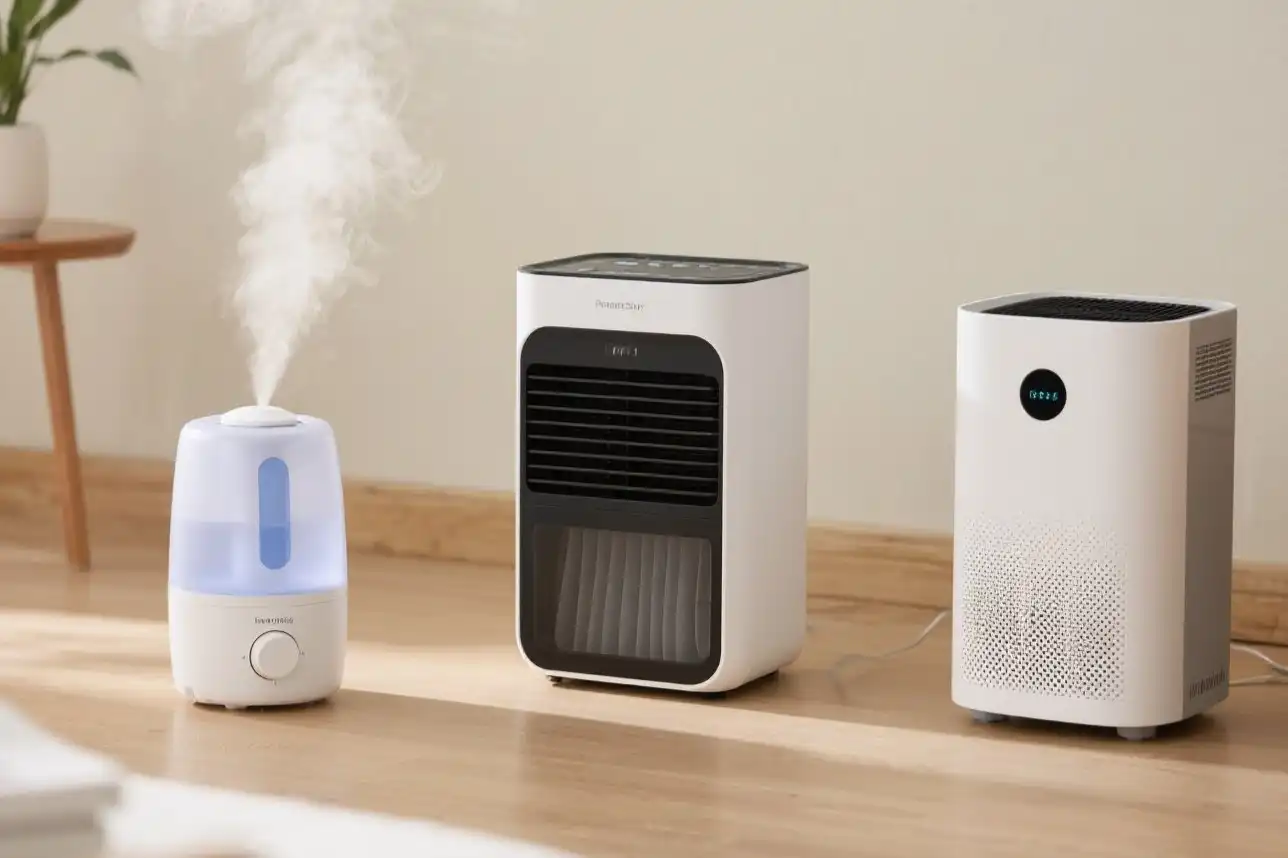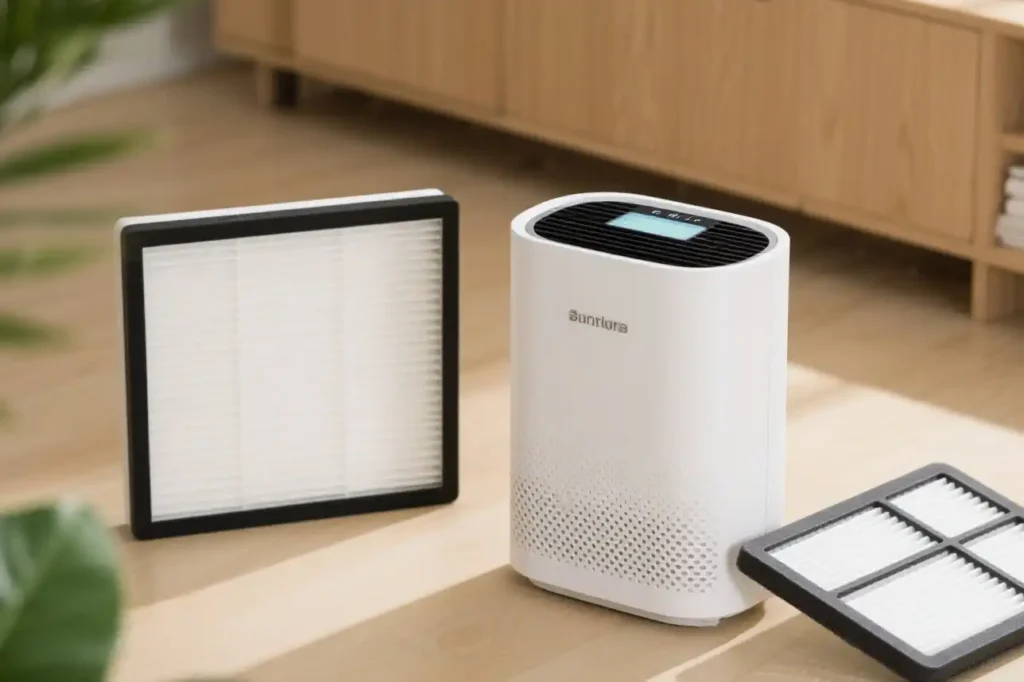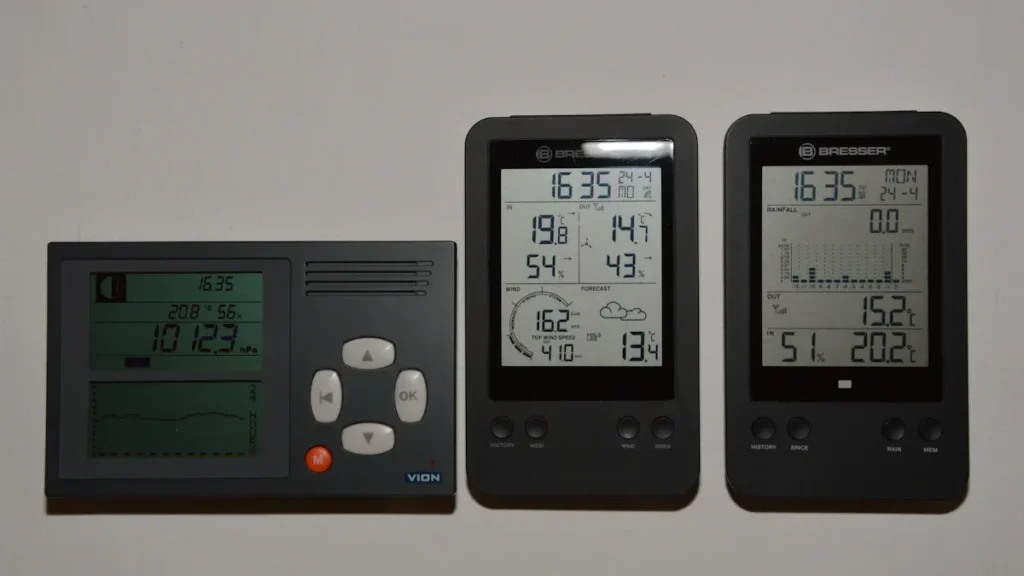
You may see dry skin, allergies, or stuffy noses at home. These issues can come from dry air, too much dampness, or things in the air like mold and dust mites.
- Dry air can cause itchy skin and sore throats.
- Too much moisture helps mold and dust mites grow.
- Things in the air, like pet dander and smoke, can cause allergies and asthma.
Picking between humidifiers, dehumidifiers, and Air Purifiers depends on your problem. Each device fixes a certain issue to help you breathe better and feel good.
Key Takeaways
- Humidifiers put water into dry air. This helps with dry skin, sore throats, and stuffy noses. They work best in winter or dry places.
- Dehumidifiers take away extra water from the air. This stops mold, mildew, and bad smells. They make wet places like basements nicer.
- Air purifiers clean the air by taking out dust, pollen, pet dander, and smoke. They help people with allergies, asthma, or who breathe in pollution.
- Pick the right device for your symptoms and home. Sometimes you need more than one for the best air.
- Clean these devices often and change filters. This keeps them working well and stops germs and dust from spreading.
Key Differences

What They Do
Humidifiers add water to the air. They make steam or mist to stop the air from being too dry. Dehumidifiers take water out of the air. This helps your home feel less wet. Air purifiers clean the air by taking out dust, pollen, and pet dander. They use filters or special tools to catch or break down these things. Each device does something different. Humidifiers make the air wetter. Dehumidifiers make it drier. Air purifiers take out bad stuff in the air.
The Environmental Protection Agency (EPA) says to keep indoor humidity between 30% and 50%. Humidifiers help if your air is too dry. Dehumidifiers help if your air feels sticky or wet. Air purifiers do not change how wet the air is. They just make the air cleaner and better to breathe.
Problems They Solve
You may get dry skin, itchy eyes, or a sore throat in winter. Humidifiers help by putting water in the air. If you see mold, smell musty odors, or feel sticky in summer, you have too much water in the air. Dehumidifiers fix this by drying the air. If you sneeze a lot, have allergies, or worry about dust and germs, air purifiers can help. They catch or destroy tiny things that make you sick or uncomfortable.
- Humidifiers are good for dry places or winter when heaters dry the air.
- Dehumidifiers help in basements, bathrooms, or any place that feels wet or smells bad.
- Air purifiers are great if you have pets, allergies, or live in a city with lots of pollution.
Always clean and take care of these devices. Dirty humidifiers or dehumidifiers can spread germs or mold. Air purifiers need new filters often to work well.
Comparison Table
| Feature | Humidifiers | Dehumidifiers | Air Purifiers |
|---|---|---|---|
| Primary Function | Adds moisture to the air | Removes excess moisture from the air | Removes airborne particles and pollutants |
| How It Works | Releases water vapor or steam | Pulls air over cold coils to collect water | Uses filters (HEPA, carbon) or ionizers to trap particles |
| Best For | Dry skin, sore throat, dry nose | Mold, mildew, musty smells, dust mites | Allergies, asthma, dust, pollen, pet dander |
| Room Size Coverage | Small rooms to whole house | Small rooms to large spaces | Small rooms to large spaces |
| Power Use | Low to moderate | Moderate to high | Low to moderate |
| Noise Level | Varies by type | Usually 48-50 dB | Usually 20-50 dB |
| Maintenance | Clean and refill water tank | Empty water tank, clean coils | Replace or clean filters |
| Health Benefits | Prevents dry air problems | Prevents mold, mildew, dust mites | Reduces allergens, improves breathing |
| Technology Used | Steam, wick, ultrasonic, impeller | Refrigeration coils, desiccants | HEPA filters, activated carbon, UV, ionization |
Tip: Pick the device that fixes your main problem. Sometimes, you might need more than one to get the best air.
Indoor Air Quality

Health Effects
Indoor air quality changes how you feel each day. Breathing dry air can make your eyes and throat hurt. Your voice might sound rough. Your skin can feel itchy. Dry air helps viruses spread faster. This means you can get sick more easily. If your home is too humid, you may see mold or dust mites. These things can make allergies and asthma worse. High humidity can also make your skin itch or get rashes. Doctors say to keep indoor humidity between 40% and 60%. This helps your nose, throat, and skin stay healthy. It also lowers your chance of getting a cold or the flu.
🏠 Having the right amount of moisture in the air helps your body fight germs. It also keeps your skin and eyes feeling good.
Common Issues
Many things can make the air inside your home or office worse. You might notice these problems more in some seasons or places. Here are some common indoor air quality problems:
- Smoke from cooking, fireplaces, or tobacco
- Mold and mildew from too much water or leaks
- Dust, pollen, and pet dander
- Chemicals from cleaners, paint, or building stuff
- Pollution from outside that comes in through doors or windows
You might have special problems based on where you live. The table below shows what problems are common in different places:
| Indoor Air Quality Issue | Cause/Climate Linkage | Where It Happens Most |
|---|---|---|
| Particulate matter (PM) | Wildfires, dust storms | Wildfire-prone, dusty regions |
| Mold and mildew | High humidity, water damage | Humid, warm climates |
| Outdoor pollutants inside | Ozone, pollen, smoke entering through openings | Urban, smoggy, or pollen-heavy areas |
| Chemical pollutants | VOCs from products, cleaning, building materials | Areas with high temperatures |
| Carbon monoxide | Portable generators during power outages | Storm-prone regions |
You can see that air quality problems change with the weather and where you live. How you use your space also matters. Knowing what problems are common in your area helps you pick the right device to keep your air clean and healthy.
Humidifiers
How They Work
Humidifiers put water into the air in your house. There are different types, and each works in its own way. The table below shows the main types and how they work:
| Humidifier Type | Functioning Mechanism | Key Features and Notes |
|---|---|---|
| Ultrasonic | Uses vibrations to turn water into a fine mist released into the air. | Quiet, energy-saving, cool or warm mist, easy to maintain. |
| Evaporative | Fan blows air through a wet wick or filter, evaporating water into the air. | Self-regulating, safe, works well with hard water, some fan noise. |
| Vaporizer (Steam) | Heats water to create steam, which is then released into the room. | Kills germs by boiling, warm mist, strong moisture output, uses more energy. |
| Cool Mist | Adds moisture without heating, releasing cool mist at room temperature. | Safe for kids and pets, good for warm climates, needs cleaning, may leave white dust. |
| Warm Mist | Heats water to emit warm mist into the air. | Comforting warmth, kills bacteria, higher energy use, possible burn risk. |
You can pick a humidifier based on your room size, how loud it is, and if it is safe for you.
Benefits
Humidifiers help you feel better when the air is dry. Here are some ways they help:
- They make dry skin feel softer and less itchy.
- They keep your nose and throat moist so you can breathe easier.
- They help with stuffy noses, dry throats, and coughing.
- They make allergy and asthma problems less bothersome by helping your body fight dust and pollen.
- They lower static electricity, which keeps electronics and clothes safe.
- They help you sleep better by stopping dry throat and stuffy noses at night.
- They protect wood furniture, floors, and musical instruments from cracking.
Using a humidifier can make your home feel nicer and help you stay healthy when the air is dry.
When to Use
You should use a humidifier if you see signs of dry air at home. Doctors say to use humidifiers in these cases:
- You have dry skin, a dry nose, nosebleeds, or a dry mouth.
- You cough, feel stuffed up, or cannot sleep well because the air is dry.
- You have more asthma or allergy problems.
- Your skin, hair, or nails feel dry or break easily.
- The humidity in your home is under 30%. The best range is 30% to 50%.
- Only use a humidifier when you need it.
- Clean your humidifier often so germs and minerals do not spread.
- Use water with few minerals to stop white dust.
Keeping the right humidity helps you feel good and stay healthy all year.
Dehumidifiers
How They Work
Dehumidifiers take extra water out of the air. There are different types, and each works in its own way. Some use cold coils to turn water vapor into liquid drops. Others use special stuff that soaks up water from the air. You can get small ones for closets or big ones for your whole house. The table below shows the main types and how they work:
| Type of Dehumidifier | Operating Principle | Pros | Cons | Ideal Uses |
|---|---|---|---|---|
| Refrigerant (Compressor) | Uses cold coils to condense moisture from warm air; collects water in tank or drains it. | Efficient in warm, humid rooms; wide range; affordable. | Less effective below 65°F; compressor noise. | Living rooms, bedrooms, warm climates. |
| Desiccant | Absorbs moisture using a drying material; releases water by heating. | Works well in cold rooms, quiet, lightweight. | Higher energy use; higher cost; lower capacity. | Basements, garages, crawl spaces, cold rooms. |
| Thermoelectric (Peltier) | Uses a cold surface for condensation; water drips into a small tank. | Very quiet, compact, low power. | Limited capacity; slow; not for large or wet rooms. | Closets, small bedrooms, RVs, boats. |
| Whole-Home (HVAC) | Connects to HVAC to remove moisture from all rooms. | Covers whole house; quiet; improves air quality. | High cost; needs professional setup; not for small areas. | Large homes with widespread humidity. |
| Mini/Desiccant Packs | Small units or packs that absorb moisture. | Cheap, easy, low maintenance. | Minimal capacity; need frequent replacement. | Closets, pantries, safes, storage. |
Pick a dehumidifier based on your room size, weather, and how much water you want to remove.
Benefits
Dehumidifiers help you keep the air dry inside. They lower the chance of mold and mildew growing. Mold can make you cough and your eyes itch. Dust mites and other things that cause allergies like damp air. If you keep the humidity between 30% and 50%, these pests do not grow as much. You may sneeze less and have fewer runny noses or watery eyes. Breathing is easier, especially if you have asthma or lung problems. Dry air also keeps your furniture, walls, and floors safe from water damage.
A dehumidifier can make a wet basement dry and comfy. It helps you breathe better every day.
When to Use
Use a dehumidifier if you notice too much water in your home. Here are some signs and times to use one:
- Humidity inside is over 50%.
- You see mold spots or smell musty air.
- There is water damage from leaks or floods.
- Bathrooms, kitchens, or basements feel damp.
- Allergy or asthma symptoms get worse when it is humid.
- Clothes or towels take a long time to dry inside.
- Water drops or fog appear on windows.
Keep your dehumidifier clean and empty the water tank often. Make sure there is good airflow and clean it regularly. This stops germs and mold from growing inside. Using a dehumidifier at the right time keeps your home healthy and nice.
Air Purifiers
How They Work
Air purifiers help clean the air in your home. They pull air in with a fan and push it through filters. The main filter is usually a HEPA filter. This filter can trap almost all tiny particles, even ones you cannot see. It catches things like dust, pollen, pet dander, and mold spores. Some air purifiers also have activated carbon filters. These filters soak up smells and gases, like smoke or cleaning chemicals. Many air purifiers use both HEPA and carbon filters together. This way, they remove both tiny bits and bad smells.
HEPA filters work in a few ways. They block big particles by stopping them. They grab medium ones by catching them as air moves by. They catch the smallest ones by making them bounce around until they stick. Some filters use static electricity to pull in even more particles.
Benefits
Air purifiers give you many good things at home. They help get rid of things that cause allergies, like pollen, dust mites, and pet dander. This makes it easier to breathe, especially if you have allergies or asthma. Air purifiers also cut down on fine dust and smoke in the air. Studies show that using HEPA filters can help people with asthma and allergies feel better. Air purifiers can also help keep kids, pregnant women, and older people safe from bad particles. Some research says air purifiers help you sleep better and have fewer allergy problems.
- Air purifiers can lower dirty air inside by up to 90%.
- They help take out particles that carry germs and viruses.
- You might sneeze, cough, or rub your eyes less.
For the best results, keep doors and windows closed when you use an air purifier.
When to Use
Use air purifiers if you have allergies, asthma, or live where the air is not clean. They work well when there are wildfires or lots of pollution outside. If you have pets, air purifiers help with hair and dander. You should also use one if someone smokes or if your house smells strong. Experts say to use air purifiers in rooms where you spend the most time, like bedrooms or living rooms.
| When to Use Air Purifiers | Why It Helps |
|---|---|
| During allergy season | Removes pollen and allergens |
| Wildfire smoke events | Reduces fine particles and smoke |
| High outdoor pollution days | Lowers indoor PM2.5 and other pollutants |
| Homes with pets | Controls pet dander and hair |
| Asthma or respiratory issues | Reduces triggers and improves breathing |
Tip: Pick an air purifier with a HEPA filter and make sure it fits your room size for the best results.
Choosing a Device
By Symptoms
Look at your symptoms to pick the right device. If you cough a lot or have dry, itchy skin, your air might be too dry. Nosebleeds can also mean dry air. A humidifier adds water to the air and helps with these problems. If you see mold or smell something musty, your air may be too wet. Sneezing and wheezing can also mean too much moisture. A dehumidifier takes out extra water and helps stop mold and dust mites. If you sneeze often, have asthma attacks, or feel tired and dizzy, there may be bad things in your air. Air Purifiers take out dust, pollen, smoke, and other things that make you sick.
Tip: Indoor air quality monitors can help you find the problem. These tools check for dust, chemicals, and how wet the air is. They give you reports so you can pick the best device.
| Symptom | Best Device |
|---|---|
| Dry skin, nosebleeds | Humidifier |
| Mold, musty smells | Dehumidifier |
| Sneezing, allergies | Air Purifiers |
| Headaches, dizziness | Air Purifiers |
By Environment
Your home and weather help you decide what to use. If you live where it is dry or use heaters a lot, the air gets dry. Humidifiers work best in these places. If you live where it rains a lot or is very humid, dehumidifiers help keep mold away. Old homes or buildings with little airflow can trap dust and chemicals. Air Purifiers help clean the air in these places. If you live near wildfires or in a city with lots of pollution, you may need Air Purifiers to get rid of smoke and dust.
- Hot, dry climate: Humidifier
- Wet, humid climate: Dehumidifier
- Old or airtight home: Air Purifiers
Using Together
You can use more than one device for better air. Humidifiers and dehumidifiers control how wet the air is. Air Purifiers take out particles and bad smells. Using them together gives you cleaner, healthier air. Some devices do two jobs, like a dehumidifier with an air purifier. These save space and work well for many homes. Separate devices let you control each part better. Always keep your devices clean for the best results.
Note: Using a humidifier and air purifier at the same time helps with dry air and allergies. Clean your humidifier often so mold does not grow.
Maintenance
Cleaning
You must keep your humidifier, dehumidifier, and air purifier clean. This helps them work well and last longer. These devices collect water, dust, or other things. Cleaning them often stops germs and mold from growing.
For humidifiers:
- Unplug the device before you clean it.
- Change the water every day. Rinse and dry the tank and base each day to stop mold and bacteria.
- Every three days, use vinegar or hydrogen peroxide to clean off minerals.
- If needed, use a 10% bleach mix to disinfect, then rinse well.
- Use distilled or demineralized water to help stop minerals from building up.
- Clean all parts every week, but do not soak any electronic parts.
- Dry the tank when you turn off the humidifier.
For dehumidifiers:
- Empty and clean the water tank often to stop bacteria and mold.
- Wipe the coils and check the drain line for clogs.
- Clean the machine quickly every month to keep it working well.
For air purifiers:
- Wipe the outside and vents with a damp cloth.
- Clean or vacuum pre-filters every few weeks.
🧽 Cleaning your devices often keeps your air fresh. It also helps your machines last longer. If you do not clean them, germs and dust can build up. This can make your air worse.
Filter Replacement
Filters catch dust, pollen, and other things in the air. You need to change or clean them on a schedule. This keeps your air clean and your devices working well.
| Device Type | Filter Type | Replacement/Cleaning Frequency |
|---|---|---|
| Air Purifier | Pre-filters | Clean or vacuum every 2-4 weeks |
| Air Purifier | HEPA filters | Replace every 6-12 months |
| Air Purifier | Activated Carbon filters | Replace every 3-6 months |
| Humidifier | Evaporative wicks | Replace every 1-3 months |
| Dehumidifier | Air filters | Wash monthly |
If you forget to change filters, dust, mold, and pet dander can spread in your home. Dirty filters make your devices work harder. This can raise your energy bills and even break your machines. Germs and bacteria can also grow on old filters. This is not safe for people with allergies or asthma.
Tip: Set reminders to check and change filters. Clean devices work better and help you breathe easier.
You can pick the best device by looking at your symptoms. Humidifiers help if your air is dry. Dehumidifiers are good if your home feels damp or has mold. Air Purifiers clean the air and help with allergies. Try to keep your home’s humidity between 30% and 50%. This keeps you comfortable and healthy.
- Look for dry skin, bad smells, or sneezing to know what to use.
- Clean your devices often so they work well.
Making your indoor air better helps you breathe and feel good every day.
FAQ
What is the main difference between a humidifier, dehumidifier, and air purifier?
A humidifier puts water into dry air. A dehumidifier takes extra water out of wet air. An air purifier makes air cleaner by taking out dust and pollen. Each one helps with a different air problem.
What problems can a humidifier help you solve?
A humidifier helps if your skin feels dry or your throat hurts. It can also help stop nosebleeds. It makes breathing easier in winter. Use one if your home feels dry or humidity is under 30%.
What should you clean most often on these devices?
Clean the water tanks on humidifiers and dehumidifiers every few days. For air purifiers, check and clean or change filters when needed. Clean machines work better and keep your air safe.
What type of air purifier filter works best for allergies?
A HEPA filter is best for allergies. It catches tiny things like pollen and pet dander. Pick an air purifier with a true HEPA filter for the best help.
What happens if you do not maintain your device?
If you do not clean or change filters, germs or mold can spread. Dirty machines may not work well. You might see more dust, bad smells, or allergy problems at home.
See also
How Humidifiers Impact Dust and Cleanliness in Your Space
Are Air Purifiers Effective for Relieving Chronic Stuffy Nose
